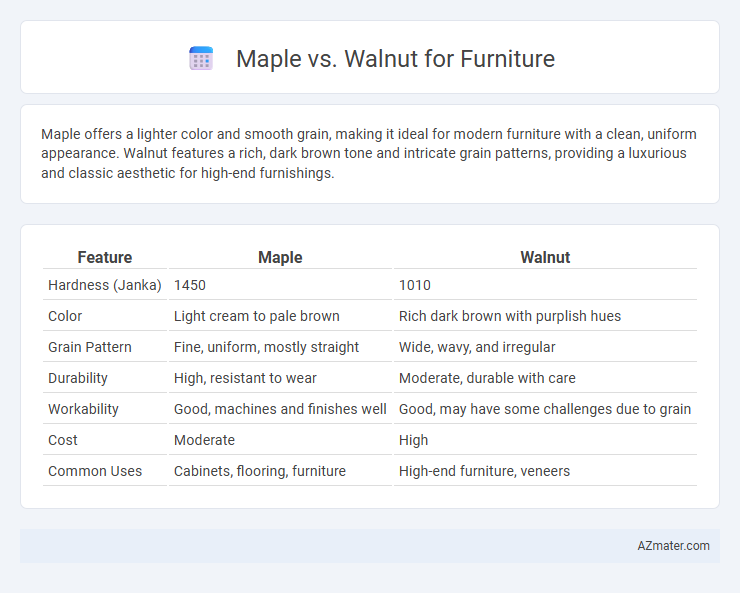Maple offers a lighter color and smooth grain, making it ideal for modern furniture with a clean, uniform appearance. Walnut features a rich, dark brown tone and intricate grain patterns, providing a luxurious and classic aesthetic for high-end furnishings.
Table of Comparison
| Feature | Maple | Walnut |
|---|---|---|
| Hardness (Janka) | 1450 | 1010 |
| Color | Light cream to pale brown | Rich dark brown with purplish hues |
| Grain Pattern | Fine, uniform, mostly straight | Wide, wavy, and irregular |
| Durability | High, resistant to wear | Moderate, durable with care |
| Workability | Good, machines and finishes well | Good, may have some challenges due to grain |
| Cost | Moderate | High |
| Common Uses | Cabinets, flooring, furniture | High-end furniture, veneers |
Overview of Maple and Walnut Woods
Maple wood, known for its light color and fine, uniform grain, offers durability and resistance to wear, making it ideal for high-traffic furniture pieces. Walnut wood is prized for its rich, dark brown hue and distinctive grain patterns, combining strength with a luxurious appearance suited for statement furniture. Both hardwoods are prized in woodworking, with maple providing a clean, modern look and walnut delivering natural elegance and warmth.
Physical Appearance and Grain Patterns
Maple furniture features a smooth, light-colored surface with subtle, consistent grain patterns, often appearing nearly uniform and ideal for a clean, modern aesthetic. Walnut showcases a richer, darker tone with complex, wavy, and swirling grain patterns that add depth and character, suited for traditional or luxurious designs. Both woods offer distinct visual appeal, with maple emphasizing brightness and simplicity, whereas walnut delivers warmth and intricate texture.
Durability and Strength Comparison
Maple offers exceptional hardness and resistance to wear, making it ideal for furniture that endures heavy use, with a Janka hardness rating of approximately 1450. Walnut, although slightly softer with a Janka hardness around 1010, provides adequate strength combined with greater flexibility, reducing the risk of cracking under stress. Both woods are durable, but maple's denser grain structure generally results in higher impact resistance and longer-lasting furniture surfaces.
Workability and Ease of Crafting
Maple offers excellent workability due to its fine, even grain, allowing for smooth cutting, sanding, and finishing, making it ideal for intricate furniture designs. Walnut is slightly harder to work with, as its coarse grain can cause tear-out during machining, but it responds well to hand tools and provides a rich, dark finish that enhances detail. Both woods are durable and suitable for furniture, but maple's ease of crafting is often preferred for precision work, while walnut's aesthetic appeal makes it desirable for high-end pieces.
Color Variations and Finishing Options
Maple furniture offers a consistent, light cream to pale golden color that enhances modern and minimalist designs, while walnut presents rich, deep brown hues with natural purples and grays ideal for classic and luxurious aesthetics. Maple's smooth, fine grain allows for a wide range of finishing techniques, including staining and bleaching, to achieve varied tones without compromising durability. Walnut's open grain structure responds well to oil, wax, and varnish finishes, highlighting its natural color variations and adding depth to the wood surface.
Cost Differences: Maple vs Walnut
Maple furniture typically costs less than walnut due to the faster growth rate and wider availability of maple trees, making it a more budget-friendly option. Walnut, known for its rich color and high durability, commands higher prices because of its slower growth and limited supply. Choosing between maple and walnut involves balancing cost constraints against desired aesthetic and longevity in furniture design.
Maintenance and Longevity
Maple furniture offers superior durability with a dense grain that resists dents and scratches, requiring minimal maintenance beyond regular dusting and occasional polishing to maintain its sheen. Walnut, prized for its rich color and natural oils, demands more frequent care such as conditioning to prevent drying and cracking but ages gracefully, often developing a desirable patina over time. Both woods provide excellent longevity when properly maintained, though maple's hardness grants it a slight edge in resisting everyday wear.
Popular Furniture Types for Each Wood
Maple is highly favored for crafting bedroom furniture such as dressers, beds, and nightstands due to its smooth grain and durability. Walnut excels in making accent pieces like coffee tables, dining tables, and cabinetry, appreciated for its rich color and striking grain patterns. Both woods are commonly chosen for flooring and office furniture, where their distinct aesthetics cater to different interior styles.
Environmental Impact and Sustainability
Maple furniture is generally considered more sustainable due to its faster growth rate and wider availability, resulting in less deforestation pressure compared to walnut. Walnut trees grow slower and are less abundant, making walnut wood less renewable and often more environmentally impactful in harvesting. Both woods require responsible forestry practices, but maple's quicker regeneration offers a lower ecological footprint for eco-conscious furniture choice.
Choosing the Right Wood for Your Furniture
Maple offers a light, consistent grain and exceptional durability, ideal for furniture that demands a smooth finish and resistance to wear. Walnut features rich, dark tones and striking grain patterns, perfect for statement pieces that emphasize elegance and warmth. Selecting the right wood depends on the desired aesthetic, durability needs, and budget, with maple providing affordability and strength while walnut delivers luxury and character.

Infographic: Maple vs Walnut for Furniture
 azmater.com
azmater.com